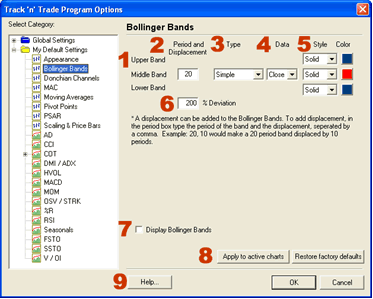
1. Bands: The Bollinger Band indicator is made up of three lines
on the chart: Upper, Middle & Lower.
2. Period and Displacement: Defines the period interval for the
Bollinger Band and Displacement. To add displacement in the period box,
type the period value first followed by a comma and then the
displacement value. (Example: 10, 20)These values affect all three
lines.
3. Type: The Bollinger Band Indicator can be based on a Simple,
Linearly Weighted, or Exponentially Smoothed Average. Click on the drop
down menu to change the type of average.
4. Data: The average can be based on four values: Open, High, Low,
or Close. Click on the drop down menu to change the data option.
5. Style & Color: Bollinger Band lines can be displayed as solid,
dashed, or dotted lines. Click on the drop down menu to specify the type
of line style. Next to the drop down menu is the color box for the line.
Click on the color box to choose a new color from the Color Palette.
6. % Deviation: Defines the displacement between the Bollinger
Bands.
7. Check this box to Display the Bollinger Bands.
8. Click on "Apply to Active Charts" if you would like to see your
selected settings on all the charts you have open. Click on "Restore
Factory Defaults" if you would like to restore original software
settings.
9. Help: Information from the manual has been integrated into the
software. When clicking on the "Help" button you will get specific
documentation based on the location of the button. You may also press F1
on your keyboard to access this information.
Back To Top |
|